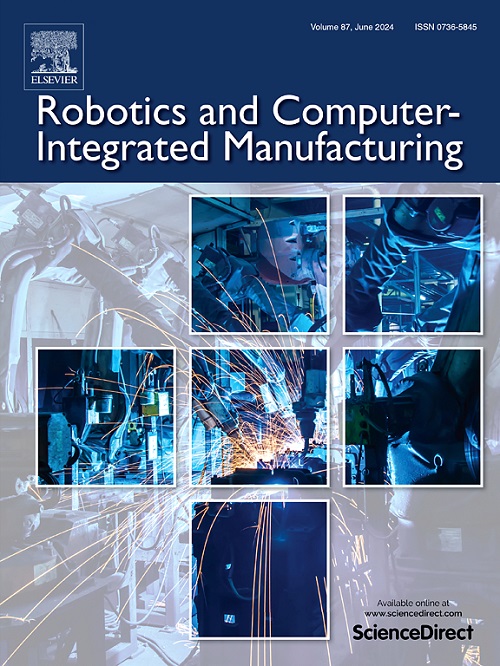Integration and calibration of an in situ robotic manufacturing system for high-precision machining of large-span spacecraft brackets with associated datum
IF 9.1
1区 计算机科学
Q1 COMPUTER SCIENCE, INTERDISCIPLINARY APPLICATIONS
引用次数: 0
Abstract
In this research, a robotic in situ manufacturing system based on the integration of measurement and machining technology is developed to address the challenge of achieving high precision and efficiency in the manufacturing of spacecraft brackets in large-scale scenarios. First, a robotic in-situ manufacturing system is established, that integrates globally unified measurement data, high-precision conversion of machining datums, and closed-loop control of end machining processes. A multiparameter optimal fitting calibration method is subsequently employed to calibrate several key parameters of the end-effector within the integrated measurement and machining process, ensuring the initial geometric accuracy of the manufacturing system. The experimental results indicate that within a 2-meter range, the average absolute error is 0.024 mm, with both the standard deviation and root mean square error not exceeding 0.038 mm. The overall system has an average error of 0.083 mm and a maximum error of 0.096 mm. Additionally, experiments are conducted in a laboratory setting simulating the manufacturing of large-span datum-associated spacecraft brackets, validating the high precision and effectiveness of the in situ robotic manufacturing system.
大跨度航天器支架相关基准高精度加工现场机器人制造系统的集成与标定
为解决航天器支架大规模制造中高精度、高效化的难题,开发了一种基于测量与加工技术相结合的机器人原位制造系统。首先,建立了集全球统一测量数据、加工基准高精度转换和末端加工过程闭环控制于一体的机器人原位制造系统;随后,采用多参数最优拟合校准方法,对测量加工一体化过程中末端执行器的几个关键参数进行了校准,保证了制造系统的初始几何精度。实验结果表明,在2 m范围内,平均绝对误差为0.024 mm,标准差和均方根误差均不超过0.038 mm。整个系统的平均误差为0.083 mm,最大误差为0.096 mm。此外,在实验室环境下进行了模拟大跨度基准相关航天器支架制造的实验,验证了原位机器人制造系统的高精度和有效性。
本文章由计算机程序翻译,如有差异,请以英文原文为准。
求助全文
约1分钟内获得全文
求助全文
来源期刊
CiteScore
24.10
自引率
13.50%
发文量
160
审稿时长
50 days
期刊介绍:
The journal, Robotics and Computer-Integrated Manufacturing, focuses on sharing research applications that contribute to the development of new or enhanced robotics, manufacturing technologies, and innovative manufacturing strategies that are relevant to industry. Papers that combine theory and experimental validation are preferred, while review papers on current robotics and manufacturing issues are also considered. However, papers on traditional machining processes, modeling and simulation, supply chain management, and resource optimization are generally not within the scope of the journal, as there are more appropriate journals for these topics. Similarly, papers that are overly theoretical or mathematical will be directed to other suitable journals. The journal welcomes original papers in areas such as industrial robotics, human-robot collaboration in manufacturing, cloud-based manufacturing, cyber-physical production systems, big data analytics in manufacturing, smart mechatronics, machine learning, adaptive and sustainable manufacturing, and other fields involving unique manufacturing technologies.

 求助内容:
求助内容: 应助结果提醒方式:
应助结果提醒方式:


